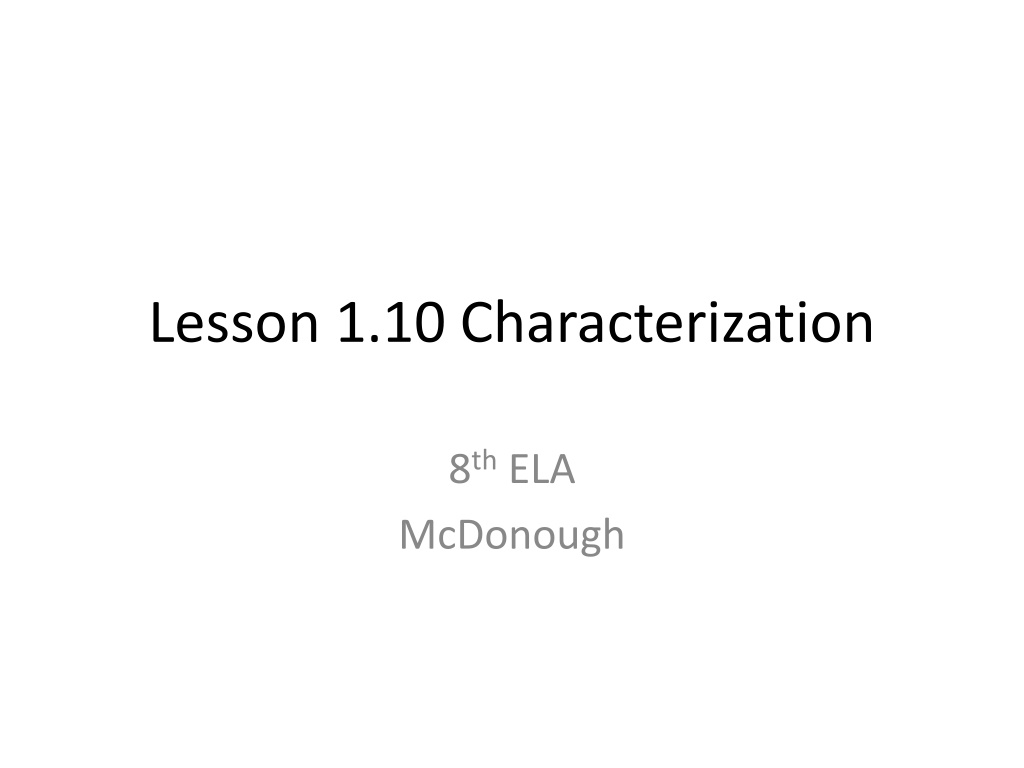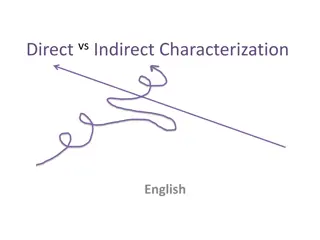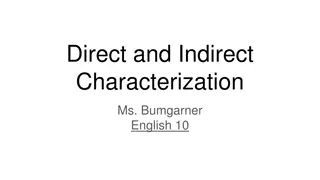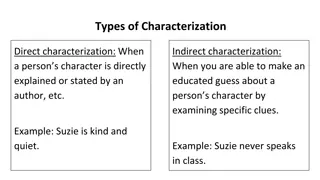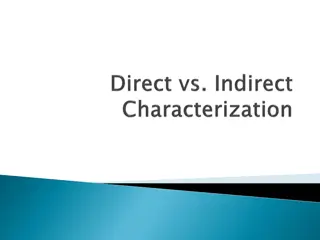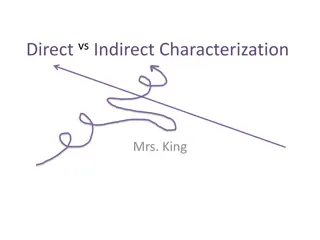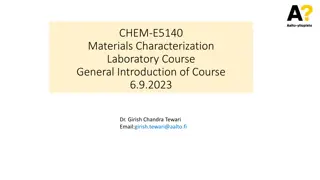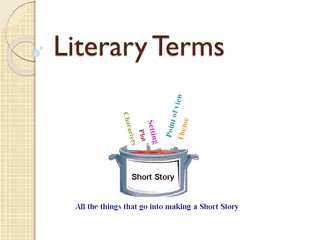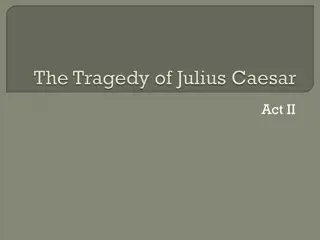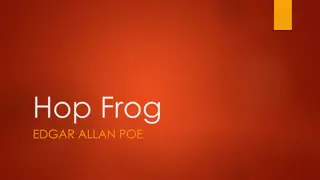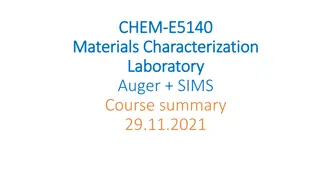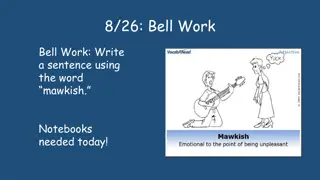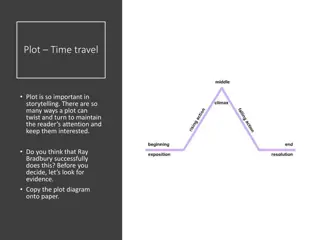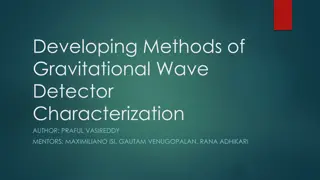Understanding Characterization in Literature
Exploring the concept of characterization through the lens of Squeaky, a dynamic character from 8th grade ELA material. Analyzing direct and indirect characterization techniques and providing text evidence to support the characterization of Squeaky as a passionate, competitive, and intolerant character. Delve into the different facets of character development through textual examples and discussions.
Download Presentation

Please find below an Image/Link to download the presentation.
The content on the website is provided AS IS for your information and personal use only. It may not be sold, licensed, or shared on other websites without obtaining consent from the author. Download presentation by click this link. If you encounter any issues during the download, it is possible that the publisher has removed the file from their server.
E N D
Presentation Transcript
Lesson 1.10 Characterization 8thELA McDonough
Dynamic Character Static Character Round Character Flat Character
Google Classroom Answer: What do we know about Squeaky? How do we know (use text evidence)?
Google Classroom Answer: What do we know about Squeaky? How do we know (use text evidence)? I know squeaky is passionate about running. Speaky does breathing exercises for she can run longer found this on page 27. Shes is going to do the race and the coach told her to let someone else win and she got mad. She is going to to run the May Day fifty-yard dash, page 27.
Google Classroom Answer: What do we know about Squeaky? How do we know (use text evidence)? I know that Squeaky does not tolerate bullying According to the first page she says I don play the dozens or believe in standing around when someone is in your face talking . She is also very Competitive because In the story she wants to win and gets ticked off when she realizes when someone can possibly be better then her.
Create your Cornell Notes Name McDonough 8/13/14 ELA Characterization
How many types of characterization are there? There are 2 types: Direct Indirect
How many types of characterization are there? Direct Characterization Indirect Characterization
How many types of characterization are there? Direct Characterization Indirect Characterization The author or narrator TELLS the reader the personality traits of the character.
How many types of characterization are there? Direct Characterization Indirect Characterization The author or narrator TELLS the reader the personality traits of the character. Example: The over-sized monster stumbled clumsily into the room.
How many types of characterization are there? Direct Characterization Indirect Characterization The author or narrator TELLS the reader the personality traits of the character. The text SHOWS the reader the personality traits of the character using STEAL. Example: The over-sized monster stumbled clumsily into the room.
How many types of characterization are there? Direct Characterization Indirect Characterization The text SHOWS the reader the personality traits of the character using STEAL. The author or narrator TELLS the reader the personality traits of the character. Example: Do you think I can walk through the room without tripping on something? said Sully. Example: The over-sized monster stumbled clumsily into the room.
What is STEAL? STEAL stands for: Speech Thoughts Effect on others Actions Looks
What is STEAL? STEAL stands for: Speech Thoughts Effect on others Actions Looks These are the tools the author uses to SHOW a character s personality traits.
Speech what and how a character speaks tells us about his/her character.
Speech what and how a character speaks tells us about his/her character. Thoughts what can we learn about a character based on his/her thoughts?
Speech what and how a character speaks tells us about his/her character. Thoughts what can we learn about a character based on his/her thoughts? Effect on others how do others think or feel about the character?
Speech what and how a character speaks tells us about his/her character. Thoughts what can we learn about a character based on his/her thoughts? Effect on others how do others think or feel about the character? Actions What does the character s choices and action say about him/her?
Speech what and how a character speaks tells us about his/her character. Thoughts what can we learn about a character based on his/her thoughts? Effect on others how do others think or feel about the character? Actions What does the character s choices and action say about him/her? Looks What does his/her physical appearance tell us?
What kind of characterization is being used here? From Hard Times by Charles Dickens: He was a rich man: banker, merchant, manufacturer, and what not. A big, loud man, with a stare, and a metallic laugh.
What part of STEAL is being used here? What does it tell us? From Margaret Atwood s The Blind Assassin: I could picture the smooth oval of Laura s face, her neatly pinned chignon, the dress she would have been wearing: a shirtwaist with a small rounded collar, in a sober colour navy blue or steel grey or hospital-corridor green. Penitential colours less like something she d chosen to put on than like something she d been locked up in. (p. 4)
What part of STEAL is being used here? What does it tell us about Violet? From Toni Morrison s Jazz I know that woman. She used to live with a flock of birds on Lenox Avenue. Know her husband, too. He fell for an eighteen-year-old girl with one of those deepdown, spooky loves that made him so sad and happy he shot her just to keep the feeling going. When the woman, her name is Violet, went to the funeral to see the girl and to cut her dead face they threw her to the floor and out of the church. She ran, then, through all that snow, and when she got back to her apartment she took the birds from their cages and set them out the windows to freeze or fly, including the parrot that said, I love you. (p. 3)
Google Classroom Quiz Google Classroom Take the quiz entitled Characterization Quiz You may use your notes This is for a grade
